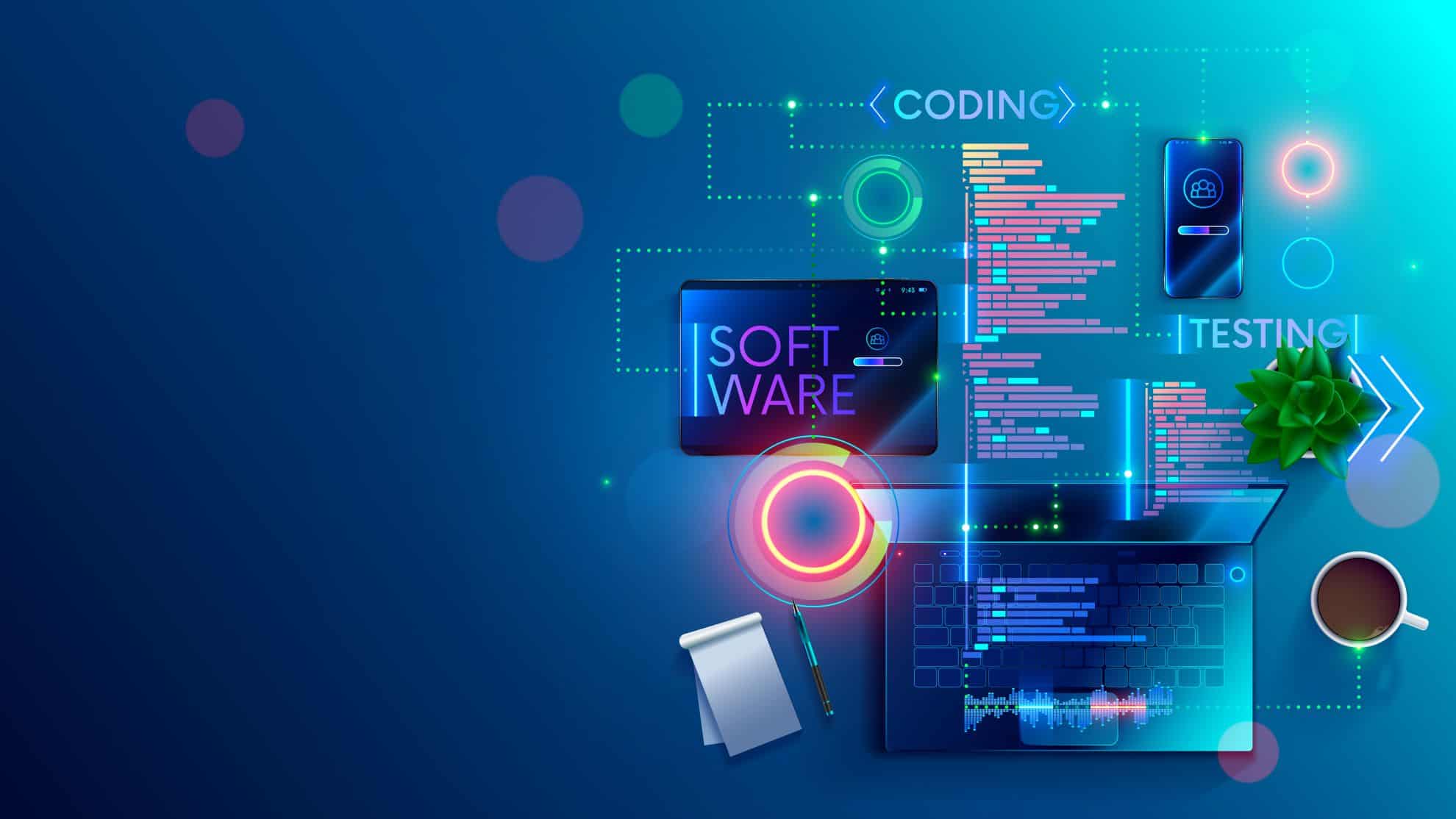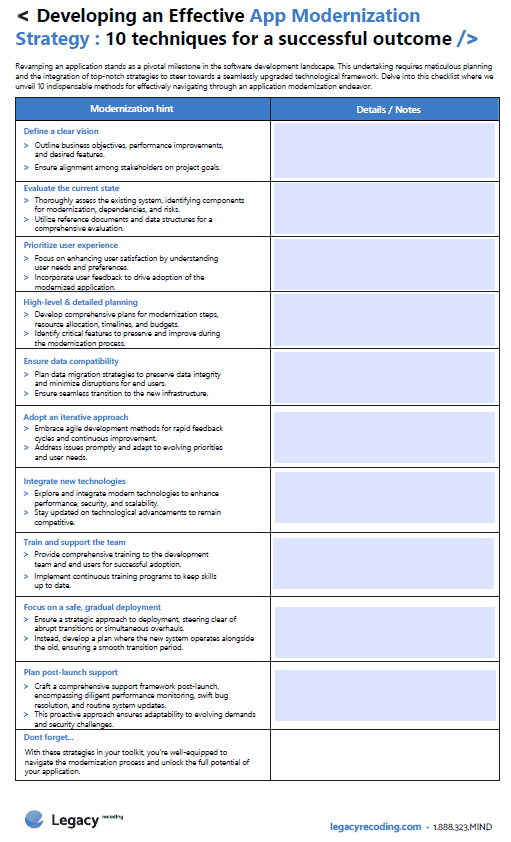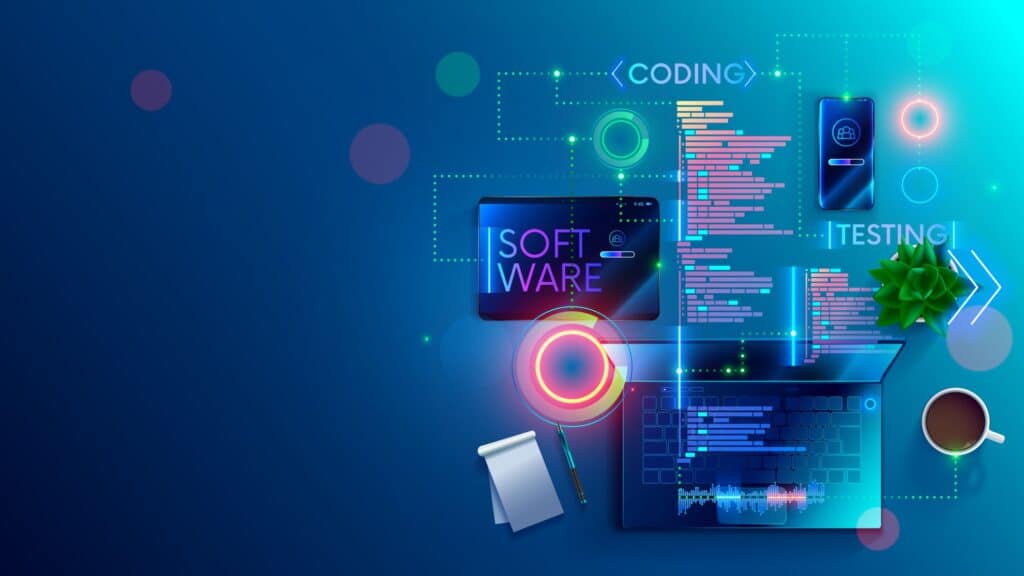Transform your app with our 10-point modernization checklist
Download our exclusive checklist now and unlock 10 winning strategies for a successful app modernization.

In today’s technological landscape, application modernization has become an imperative for companies wishing to maintain their competitiveness and agility. But what do we really mean by software modernization, and why is it so crucial?
Many companies are faced with legacy IT systems that are often obsolete and unsuited to today’s requirements. This legacy software can hamper innovation, limit your ability to adapt to new challenges and, by the same token, no longer correspond to your business processes, which have evolved over time.
This is where application modernization comes in. By rethinking and updating these old systems, companies can not only improve their operational efficiency, but also boost their agility and competitiveness.
In this comprehensive article, we’ll take a look at the concept of application / software modernization, defining it precisely, examining the challenges inherent in legacy systems, and highlighting the vital importance of adopting effective modernization strategies.
Understanding application modernization
Legacy software modernization involves converting, rewriting or porting a legacy system to modern computer programming languages, architectures, software libraries, protocols or hardware platforms.
Software modernization, whether of legacy systems or existing software, is primarily aimed at improving system performance, scalability, security and maintainability.
By adopting new technologies and updating architectures, companies can :
Limitations of legacy systems
Legacy systems are often difficult to integrate with modern systems, limiting their ability to interact effectively with them. As a result, the data they contain remains compartmentalized, hampering the exploitation of technologies such as biometrics, artificial intelligence and access to data available in the cloud.
What’s more, the maintenance of these systems is often complicated by a lack of documentation, skills and necessary components, which may be obsolete or even missing. This complexity can make maintenance potentially costly, not least because of the scarcity of experts capable of maintaining them effectively.
Legacy systems are also subject to :
In addition, these systems often lack the flexibility to adapt to new functional requirements or increased business volume, limiting their scalability and ability to respond effectively to changing business demands.

Transform your app with our 10-point modernization checklist
Download our exclusive checklist now and unlock 10 winning strategies for a successful app modernization.

Modernization strategy: preserving critical functionality
Opting for an effective modernization strategy is essential for organizations seeking to exploit the full potential of their existing systems. By strategically assessing their technology ecosystem, business objectives and operational requirements, organizations can design tailored modernization roadmaps that meet their unique challenges and objectives.
Whether incremental upgrades, phased migrations or complete system overhauls, modernization initiatives must be carefully planned, executed and monitored to ensure success.
Real-world example
To illustrate the benefits of software modernization, consider the case of Company X, a global enterprise facing significant challenges due to outdated legacy systems. In many ways, the situation is similar to trying to operate in a run-down building with crumbling infrastructure and obsolete equipment.
Recognizing the urgency of change, Company X embarked on a major modernization project, building a new structure alongside the old one, while opting for a phased roll-out. This approach allows operations to be maintained by starting migrations once each floor of the new building is ready, thus avoiding chaos in the transition between the old and the new. Leveraging state-of-the-art technologies, Company X transformed its obsolete systems into a modern, agile digital ecosystem.
The results have been remarkable. Like transforming a decrepit building into a gleaming skyscraper, Company X experienced significant improvements in operational efficiency, cost reduction and customer satisfaction. Thanks to its modernized systems, Company X has been able to adapt rapidly to changing market demands, innovate at a steady pace and maintain a competitive edge in its industry.
In conclusion, software modernization is not merely a technical endeavor; it is a strategic imperative for organizations seeking to thrive in the digital age. By embracing modernization initiatives, businesses can unlock new opportunities, drive innovation, and stay ahead of the competition.
However, success requires a concerted effort, with organizations investing in robust modernization strategies, skilled talent, and cutting-edge technologies.
With the right approach, organizations can transform their legacy systems into agile, scalable, and future-ready assets that propel them towards sustained success in today’s dynamic business environment.
Revolutionize your approach with our guide: Crafting a winning application modernization strategy.
Uncover 10 techniques to modernize your strategy with assurance.

Tell us more about your needs so that we can better route your project to our specific SWAT team.
1
During the brainstorming phase, we work with you to identify potential solutions to your business challenges to generate the technology response that aligns with your business objectives.
2
Through our requirements gathering process, we work closely with you to define and prioritize your needs, ensuring that our solutions are tailored to meet your specific requirements.
3
This phase marks the beginning of our partnership. We’ll finalize the project plan and establish clear communication channels to ensure a smooth and successful project execution.